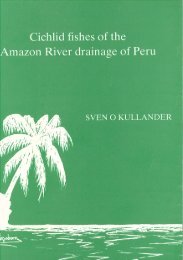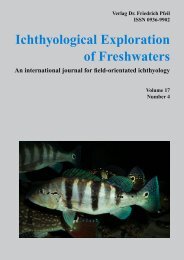Family Cichlidae (Cichlids) - Sven Kullander
Family Cichlidae (Cichlids) - Sven Kullander
Family Cichlidae (Cichlids) - Sven Kullander
Create successful ePaper yourself
Turn your PDF publications into a flip-book with our unique Google optimized e-Paper software.
Check List of the Freshwater Fishes of South and Central America<br />
Distribution: South America: Amazon River basin in Peru, Colombia<br />
and Brazil; Oyapock River basin.<br />
Countries: Brazil, Colombia, Peru,<br />
Remarks and references: Redescription based on Peruvian material<br />
in <strong>Kullander</strong> (1986: 51), with diagnosis, description, distribution<br />
and illustrations.<br />
Common names: Kounanni (French Guiana), Toukounaré (French<br />
Guiana), Tucunare (Peru), Tucunaré-açu (Brazil), Tucunari<br />
(Peru)<br />
Cichla ocellaris Bloch & Schneider, 1801<br />
Cichla ocellaris Bloch & Schneider, 1801: 340, pl. 66. Type locality:<br />
India orientali. Holotype: ZMB 2839.<br />
Acharnes speciosus Müller & Troschel, 1849: 622. Type locality:<br />
Küste; Mündung des Essequibo.<br />
Maximum length: 41 cm SL<br />
Distribution: South America: Guianan rivers from the Marowijne<br />
drainage in Suriname and French Guiana to the Essequibo drainage<br />
in Guyana.<br />
Countries: French Guiana, Guyana, Suriname<br />
Common names: Kounanni (French Guiana), Lukanani (Guyana),<br />
Pavón (Venezuela), Toukounaré (French Guiana), Tucunaré açu<br />
(Brazil)<br />
Cichla orinocensis Humboldt, 1821<br />
Cichla orinocensis Humboldt in Humboldt & Valenciennes, 1821:<br />
167, pl. 45 (fig. 3). Type locality: les rives de l’Orénoque et du<br />
Guainia ou Rio Negro. No types preserved.<br />
Cichla argus Valenciennes in Humboldt & Valenciennes, 1821:<br />
169. Type locality: [Not stated]. Holotype: MNHN A.1042.<br />
Maximum length: 61.7 cm SL<br />
Distribution: South America: Orinoco River basin, in tributaries of<br />
the Orinoco River in Colombia and Venezuela; Amazon River<br />
basin, in the Negro River basin.<br />
Countries: Brazil, Colombia, Venezuela<br />
Remarks and references: Redescription based on Venezuelan<br />
material in Machado-Allison (1971), as C. ocellaris.<br />
Cichla temensis Humboldt, 1821<br />
Cichla temensis Humboldt in Humboldt & Valenciennes, 1821:<br />
169. Type locality: Temi. No types known.<br />
Cichla atabapensis Humboldt in Humboldt & Valenciennes, 1821:<br />
168. Type locality: l’Orénoque; Rio Atabapo. No types known.<br />
Cichla tucunare Heckel, 1840: 409. Type locality: Rio-branco.<br />
Types in NMW, not found.<br />
Cychla flavo-maculata Jardine, 1843: 145, pl. 6. Type locality: Rio<br />
Negro and Padauiri. No types known.<br />
Cychla trifasciata Jardine, 1843: 151, pl. 9. Type locality: Rio<br />
Negro; Padauiri. No types known.<br />
Cichla unitaeniatus Magalhães, 1931: 225. Type locality: Rio<br />
Negro e do Purus. No types preserved.<br />
Maximum length: 75 cm TL<br />
Distribution: South America: Amazon River basin in the Negro<br />
and Uatumã River drainages; Orinoco River basin in tributaries<br />
of the Orinoco River in Venezuela and Colombia.<br />
Countries: Brazil, Colombia, Venezuela<br />
Remarks and references: Redescription based on Venezuelan<br />
material in Machado-Allison (1971).<br />
Common names: Pavón (Venezuela), Tucunaré (Brazil)<br />
CICHLASOMA<br />
Cichlasoma Swainson, 1839: 230. Type species: Labrus bimaculatus<br />
Linnaeus, 1758. Under the plenary power of the International<br />
Commission on Zoological Nomenclature (2000: 131). Gender:<br />
neuter. As Cichlaurus on p. 173; Swain (1882: 284) acts as first<br />
reviser selecting Cichlasoma (see Bailey 1957: 303). Originally<br />
as Plesiops (Cichlasoma).<br />
Cichlaurus Swainson, 1839: 173. Type species: Labrus bimaculatus<br />
Linnaeus, 1758. Type by being a replacement name. Gender:<br />
masculine. Without species but clear from text that this was another<br />
name for Cichlasoma Swainson (1839: 230); Swain (1882:<br />
284), acts as first reviser selecting Cichlasoma.<br />
Cichlosoma Regan, 1905a: 61. Type species: Labrus bimaculatus<br />
Linnaeus, 1758. Type by being a replacement name. Gender:<br />
neuter.<br />
‘Cichlasoma’ aguadae Hubbs, 1936<br />
Cichlasoma urophthalmus aguadae Hubbs, 1936: 270, pl. 14 (fig.<br />
7). Type locality: Aguada at Tuxpeña, interior Campeche, about<br />
90 km. south, and 40 km. east of Champoton. Holotype: UMMZ<br />
64477.<br />
Maximum length: 9.5 cm SL<br />
Distribution: North America: Atlantic slope, Tuxpeña, Mexico.<br />
Countries: Mexico<br />
Remarks and references: The generic allocation of this species is<br />
still uncertain. It belongs to the tribe Heroini, but is maintained as<br />
an Incertae Sedis species of Cichlasoma pending a revision of<br />
heroin cichlids traditionally assigned to the cichlasomatin genus<br />
Cichlasoma.<br />
‘Cichlasoma’ alborum Hubbs, 1936<br />
Cichlasoma urophthalmus alborum Hubbs, 1936: 268, pl. 13 (fig.<br />
3). Type locality: Rio Usumacinta at Montecristo, Tobasco, Mexico.<br />
Holotype: USNM 50501.<br />
Maximum length: 18.6 cm SL<br />
Distribution: North America: Atlantic slope, in the Usumacinta<br />
River, Mexico.<br />
Countries: Mexico<br />
Remarks and references: The generic allocation of this species is<br />
still uncertain. It belongs to the tribe Heroini, but is maintained as<br />
an Incertae Sedis species of Cichlasoma pending a revision of<br />
heroin cichlids traditionally assigned to the cichlasomatin genus<br />
Cichlasoma.<br />
‘Cichlasoma’ amarum Hubbs, 1936<br />
Cichlasoma urophthalmus amarum Hubbs, 1936: 272, fig. 1. Type<br />
locality: A salt or brackish water lagoon on Mujeres Island, off<br />
the east coast of Yucatan, near the tip of the peninsula. Holotype:<br />
USNM 50504.<br />
Maximum length: 15.8 cm SL<br />
Distribution: North America: Caribbean coast, Isla Mujeres, off<br />
the eastern coast of Yucatán Peninsula.<br />
Countries: Mexico<br />
Remarks and references: The generic allocation of this species is<br />
still uncertain. It belongs to the tribe Heroini, but is maintained as<br />
an Incertae Sedis species of Cichlasoma pending a revision of<br />
heroin cichlids traditionally assigned to the cichlasomatin genus<br />
Cichlasoma.<br />
Cichlasoma amazonarum <strong>Kullander</strong>, 1983<br />
Cichlasoma amazonarum <strong>Kullander</strong>, 1983a: 115, pl. 5 (fig. 2).<br />
Type locality: Peru, depto Loreto, R. Ampiyacu system, little<br />
upstreams of Pebas, Sacarita del Tuyé, right bank tributary of the<br />
R. Ampiyacu, floating meadow near mouth. Holotype: NRM<br />
39271.<br />
Maximum length: 11.4 cm SL<br />
Distribution: South America: Amazon River basin, from the Ucayali,<br />
Huallaga, Amazon and Yavarí River drainages in Peru, along<br />
the mainstream Amazon-Solimões River in Colombia and Brazil<br />
to the mouth; also in French Guyana and Amapá State.<br />
Countries: Brazil, Colombia, French Guiana, Peru<br />
Common names: Acará (Brazil), Bujurqui (Peru), Prapra (French<br />
Guiana)<br />
Cichlasoma araguaiense <strong>Kullander</strong>, 1983<br />
Cichlasoma araguaiense <strong>Kullander</strong>, 1983a: 252, pl. 14 (fig. 1).<br />
Type locality: Brasil, est. Mato Grosso, R. Araguaia system,<br />
621




